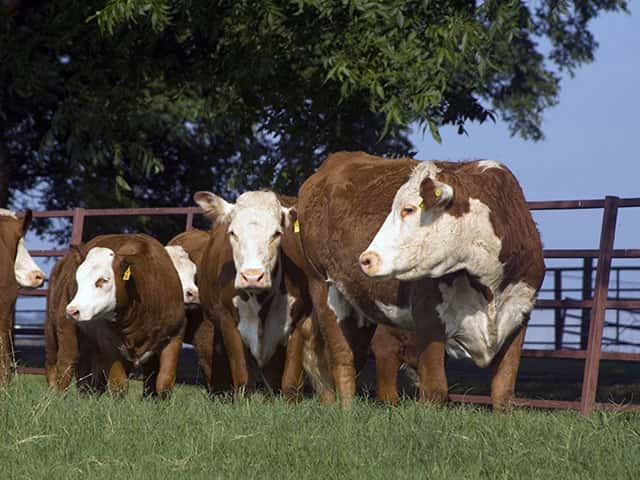OMAHA (DTN) — Weaning is a high stress time for calves as well as producers. If not handled correctly, it can lead to increased illness, reduced gains and additional costs.
Weaning time is stressful for calves as well as the producers. Proper steps can help reduce illness and limit costs. There are several different approaches cow/calf producers use to reduce calf sickness and make the entire process less stressful. While most producers have a preferred weaning technique, the focus is the same –keeping stress low for both calf and dam.
One method many rely on is two-step weaning. Taylor Grussing, South Dakota State University (SDSU) cow/calf field specialist, explained this approach relies on the use of nose flaps to prevent the calf suckling. The flaps are put on calves four to seven days before they are removed from dams. Step two is the removal of calves from the cowherd. This method has been shown to decrease bawling and walking fence lines, compared to traditional abrupt, or hard, weaning.
“This helps give them a few days to realize they must find a different kind of feed to eat before mom is completely removed from the picture,” Grussing said.
Another popular approach for separating dam and calf is fenceline weaning. Calves can still see and even touch their dams through the fence, but they cannot nurse.
Jay and Chyenne Smith, operators of J Lazy S Angus Ranch, near Carmen, Idaho, use both fenceline weaning, which they refer to as “soft weaning” and hard weaning, where calves are hauled to another location.
Bob Birdsell, a farmer and cow/calf producer, raises Angus and Simmental cattle in the rolling hills of northwestern Missouri near Stanberry. He relies on modified fenceline weaning, where a pen separates cows and calves. They are about 40 yards apart, but can still see each other.
“This works pretty well for us,” he said.
NUTRITION KEY
As calves are weaned, it's critical to make sure they get off to a good start nutritionally. Grussing noted this sets them up for successful performance down the road.
This season some calves in the state were weaned much earlier than normal because of drought — some by July 1, Grussing said. The drought also led to an increased number of both cows and spring calves at sale barns across the state throughout the summer. In areas of the state not affected by the drought, normal weaning in September and October occurred, or will occur, and those calves will be marketed as normal.
Grussing said many weaned calves start out with long stem hay fed in bunks. This teaches them where there food will come from.
“We want calves coming to the bunks each day. So fluffing the hay and allowing them to nibble on it throughout the day is important to getting the rumen off to a good start,” she said.
After seven to 10 days, calves should be consuming 2.5{a169222e5c003bec48f63dd57bc39383f42c8e994ade26e015ce9d78e5f0b614} to 3{a169222e5c003bec48f63dd57bc39383f42c8e994ade26e015ce9d78e5f0b614} of body weight in a daily ration. Along with hay, a good starter ration should include protein supplements, by-products and an energy source.
“Simple home-grown rations can be utilized as long as they are high quality and palatable for the calves,” Grussing told DTN. “Each bite they take needs to be concentrated with energy and protein to meet their needs.”
The nutrition of weaned calves is one area the Smiths of Idaho spend a lot of time focusing on. The ranch has both a small registered Angus herd, as well as a commercial herd.
They supply calves fresh pasture or grass hay and fresh water at weaning. After three days, calves go out to graze the ranch's hay fields.
“They start with grass hay and then as soon as the first freeze they move to the alfalfa fields,” the Smiths said. “If it looks to be a warm fall, we will cut the alfalfa and let them graze the windrows.”
The ranchers make sure calves have access to loose mineral, salt blocks and sometimes they feed bloat blocks. Pasture bloat can occur when cattle graze wheat pastures or legumes, including alfalfa.
In Missouri, Birdsell feeds weaned calves by hand twice a day. This fall he changed some of his typical feed ingredients in response to the Veterinary Feed Directive (VFD). He noted the VFD took away some of the feed options he used at weaning in the past, specifically those containing antibiotics.
“We could get our vet involved, but I think we will just go without these ingredients this year,” he said.
GOOD HEALTH PLAN
Disease prevention is key to early calf health. Pre-weaning vaccines guard against the spread of disease brought on by stress and commingling. If no pre-weaning vaccinations are given, post-weaning shots should be administered as soon as possible based on veterinarian recommendations, Grussing added.
Both Birdsell and the Smiths utilize a two-step health plan for calves. In Birdsell's case, vaccines are administered either right before or after weaning.
In the Smiths case, they noted: “Our sold loads of calves have specifics that we ensure weaning 30 to 45 days, and a vaccination program.”
Russ Quinn can be reached at russ.quinn@dtn.com
(VM/ES)
(DTN/The Progressive Farmer photo by Becky Mills)
© Copyright 2017 DTN/The Progressive Farmer. All rights reserved


